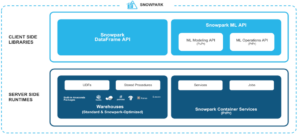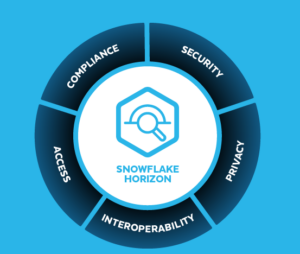

(Kim Kuperkova/Shutterstock)
Snowflake made a slew of announcements today during its “Snowday 2023” launch event, including a new generative AI offering dubbed Cortex, updates to its Snowpark environment for traditional machine learning, support for Iceberg Tables, updates to its Horizon data governance tool, and a new Snowflake Notebook.
The company describes Snowflake Cortex as a fully managed service for building and running all sorts of AI applications in its cloud, including generative AI applications. Currently in private preview, Cortex spans a set of serverless “specialized functions” and “general-purpose functions” that customers can call with a few lines of SQL or Python.
Specialized functions in Cortex include language models that can detect sentiment in text, summarize text, extract answers from text, and translate text into other languages. There are also specialized functions for tapping into traditional machine learning models, such as for forecasting, anomaly detection, and classification.
In the “general-purpose function” bucket, we find large language models such as Meta’s Llama 2 and several “high-performance Snowflake LLMs” that will enable customers to “chat” with their data, the company says. We also find things like vector embeddings and vector search capabilities in the general-purpose function bucket of Cortex. Snowflake is also adding vector as a native data type within its data cloud.
As a serverless offering on the Snowflake Data Cloud, Cortex is simple to use doesn’t require any AI expertise, doesn’t require the need to set up GPUs, and borrows from Snowflake’s inherent security, says Sridhar Ramaswamy, Snowflake’s senior vice president of AI.
“This is great for our users because they don’t have to do any provisioning,” Ramaswamy said at a press conference last week. “We do the provisioning. We do the deployment. It looks just like an API, similar to, say, what OpenAI offers, but it’s done right within Snowflake. Data does not leave anywhere. And it comes with the kind of guarantees that our customers want and demand, which is that the data is obviously isolated. It’s never intermingled in any kind of cross-customer training.”
As part of its Cortex launch, Snowflake is also unveiling private previews of a few “native LLM experiences” that will provide GenAI capabilities that leverage Cortex functions. This includes Document AI, Snowflake Copilot, and Universal Search.
These building blocks, combined with the public preview of support for the Streamlit development environment in Snowflake, should help to turbo-charge LLM and GenAI application development, such as for chatbots, Ramaswamy said.
“A chatbot is nothing but a combination of vector indexes and a language model that uses retrieval done on the index to do the prompting,” he said. “And this is when we give the power into the hands of our users so that the more adventurous among them can build meaningful applications very, very quickly.”
Snowpark Updates and a Notebooks Too
The company also today launched a private preview of Snowflake Notebooks, which enable users to explore data and develop machine learning applications in a familiar Juptyer-like environment running on their laptop.
“This brings you a cell-based development experience where you can build on a cell, execute, and iteratively grow–mix and match across SQL, Python, and markdown,” said Jeff Hollan director of product for Snowflake Developer Platform and Snowpark.

Snowpark provides libraries and runtimes for manipulating non-SQL data in Snowflake (Image source: Snowflake)
“A big part of analyzing and understanding your data is visualization, and this notebook integrated directly with Streamlit visualizations,” he continued. “I often like to say one my favorite things about Steramlit is there is no such thing as an ugly Streamlit app. Streamlit just has beautiful visualization out of the box, and you can use those exact visualizations inside of your notebook to get insight into your data and what it’s doing.”
Snowflake Notebooks is a component of Snowpark, the company’s collection of Python, Java, and Scala runtimes and libraries for working with non-SQL data housed in Snowflake. The company made several other announcements regarding Snowpark aimed at customers who are trying to develop traditional machine learning models on data housed in Snowflake.
For starters, it announced that the Snowpark ML Modeling API will soon be generally available. This API empowers developers and data scientists to scale out feature engineering and simplify model training for faster and more intuitive model development in Snowflake, according to the company.
It also announced Snowpark Model Registry, which will provide a one-stop-shop for cataloging and accessing all of the models used across the Snowpark environment, including traditional ML as well as LLMs for GenAI. The Snowpark Model Registry will be in public preview soon.
Lastly, it announced the start of a private preview for the Snowflake Feature Store, which will provide a repository for creating, storing, managing, and serving the ML features that data scientists and machine learning engineers want to use to train a model, as well as for running inference.
“These are three really exciting building blocks,” Hollan said. “The theme of all of these is allowing you to take those best practices that exist in the machine learning ecosystem but bringing in the simplicity, and the scale, and performance that SF can uniquely provide.”
New Horizon for Governance
Data governance has always been a core building block for developing and sustaining AI development. But now that the GenAI explosion is turbocharging interest in AI, data governance has emerged as a real stumbling block that could prevent all forms of AI success.
To that end, Snowflake today made updates to Horizon, its pre-existing offering for automating data governance tasks such as compliance, security, privacy, interoperability, and access capabilities in Snowflake’s cloud.
Without good data, every AI project will fail. With that in mind, Snowflake is launching a Horizon capability called Data Quality Monitoring. Currently in private preview, Data Quality Monitoring is aimed at making it easier for customers to measure and record data quality metrics for reporting, alerting, and debugging, the company said. Another new Horizon capability in private preview is Data Lineage, which is designed to give customers “a bird’s eye visualization of the upstream and downstream lineage of objects,” the company says.
On the privacy and security front, customers soon will be able to utilize Differential Privacy Policies, a new Snowflake capability that will allow customers to protect sensitive data “by ensuring that the output of any one query does not contain information that can be used to draw conclusions about any individual record in the underlying data set,” the company says. It’s currently in development.
Snowflake is also shipping new data classifiers that will enhance customers capability to define what sensitive data means in their business. Finally a new Trust Center, which will soon be in private preview, aims to help customers streamline their cross-cloud security and compliance monitoring by putting it in one place.
Cost is a perpetual concern when you run in the cloud, and something that Snowflake has said that it’s sensitive to. To that end, it is adding a new Cost Management Interface to Horizon that will enable admins “to easily understand, control, and optimize their spend,” the company says.
Last but not least, the company announced a public preview for Iceberg Tables. The company has already made Iceberg its preferred open table format, but there were some differences in how Iceberg tables were supported. With this announcement, it’s moving to simplify and unify that support.
“Instead of two separate table types for Iceberg, we are combining Iceberg External Tables and Native Iceberg Tables into one table type with a similar user experience,” Snowflake engineers Ron Ortloff and Steve Herbert wrote in a blog earlier this year. “You can easily configure your Iceberg catalog to match the capabilities you need.”
Related Items:
Databricks Versus Snowflake: Comparing Data Giants
Snowflake Gives Everybody a Little Something at Summit
Open Table Formats Square Off in Lakehouse Data Smackdown
April 21, 2025
- MIT: Making AI-Generated Code More Accurate in Any Language
- Cadence Introduces Industry-First DDR5 12.8Gbps MRDIMM Gen2 IP on TSMC N3 for Cloud AI
- BigDATAwire Unveils 2025 People to Watch
April 18, 2025
- Snowflake and PostgreSQL Among Top Climbers in DB-Engines Rankings
- Capital One Software Unveils Capital One Databolt to Help Companies Tokenize Sensitive Data at Scale
- Salesforce Launches Tableau Next to Streamline Data-to-Action with Agentic Analytics
- DataVisor Named a Leader in Forrester Wave for AML Solutions, Q2 2025
- GitLab Announces the General Availability of GitLab Duo with Amazon Q
- Anthropic Joins Palantir’s FedStart Program to Deploy Claude Application
- SnapLogic Announces Partnership with Glean to Transform the Agentic Enterprise
April 17, 2025
- Qlik Highlights Real-World Enterprise AI at Qlik Connect 2025 with Lenovo, Visa, and Reworld
- SnapLogic Ushers in the Era of Infinite AI Workforce for the Agentic Enterprise With AgentCreator 3.0
- Devo Highlights Analyst Overload in Push Toward Alertless SOC
- InfluxData Launches InfluxDB 3 Core and Enterprise for Real-Time Time Series Data
- Informatica and Carnegie Mellon University Partner to Drive Innovation in GenAI for Data Management
- SnapLogic Unveils Next-Gen API Management Solution to Power the Composable and Agentic Enterprise
- Monte Carlo Launches Observability Agents To Accelerate Data + AI Monitoring and Troubleshooting
- Berkeley Lab Spotlights Efficient Method for Faster Topological Data Analysis
- Vultr Recognized for Strength in Data Sovereignty and Security in 2025 Omdia Sovereign Cloud Report
April 16, 2025
- PayPal Feeds the DL Beast with Huge Vault of Fraud Data
- OpenTelemetry Is Too Complicated, VictoriaMetrics Says
- Will Model Context Protocol (MCP) Become the Standard for Agentic AI?
- Accelerating Agentic AI Productivity with Enterprise Frameworks
- When Will Large Vision Models Have Their ChatGPT Moment?
- Thriving in the Second Wave of Big Data Modernization
- What Benchmarks Say About Agentic AI’s Coding Potential
- Google Cloud Preps for Agentic AI Era with ‘Ironwood’ TPU, New Models and Software
- Google Cloud Fleshes Out its Databases at Next 2025, with an Eye to AI
- Can We Learn to Live with AI Hallucinations?
- More Features…
- Grafana’s Annual Report Uncovers Key Insights into the Future of Observability
- Google Cloud Cranks Up the Analytics at Next 2025
- Reporter’s Notebook: AI Hype and Glory at Nvidia GTC 2025
- New Intel CEO Lip-Bu Tan Promises Return to Engineering Innovation in Major Address
- AI One Emerges from Stealth to “End the Data Lake Era”
- Snowflake Bolsters Support for Apache Iceberg Tables
- SnapLogic Connects the Dots Between Agents, APIs, and Work AI
- Excessive Cloud Spending In the Spotlight
- Mathematica Helps Crack Zodiac Killer’s Code
- Big Growth Forecasted for Big Data
- More News In Brief…
- Gartner Predicts 40% of Generative AI Solutions Will Be Multimodal By 2027
- MinIO: Introducing Model Context Protocol Server for MinIO AIStor
- Dataiku Achieves AWS Generative AI Competency
- AMD Powers New Google Cloud C4D and H4D VMs with 5th Gen EPYC CPUs
- Deloitte Survey Finds AI Use and Tech Investments Top Priorities for Private Companies in 2024
- Prophecy Introduces Fully Governed Self-Service Data Preparation for Databricks SQL
- Seagate Unveils IronWolf Pro 24TB Hard Drive for SMBs and Enterprises
- CData Launches Microsoft Fabric Integration Accelerator
- MLCommons Releases New MLPerf Inference v5.0 Benchmark Results
- Opsera Raises $20M to Expand AI-Driven DevOps Platform
- More This Just In…




























